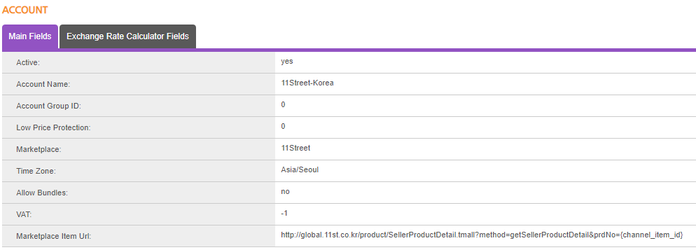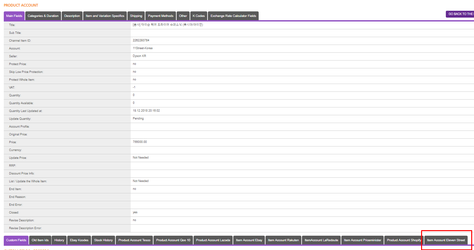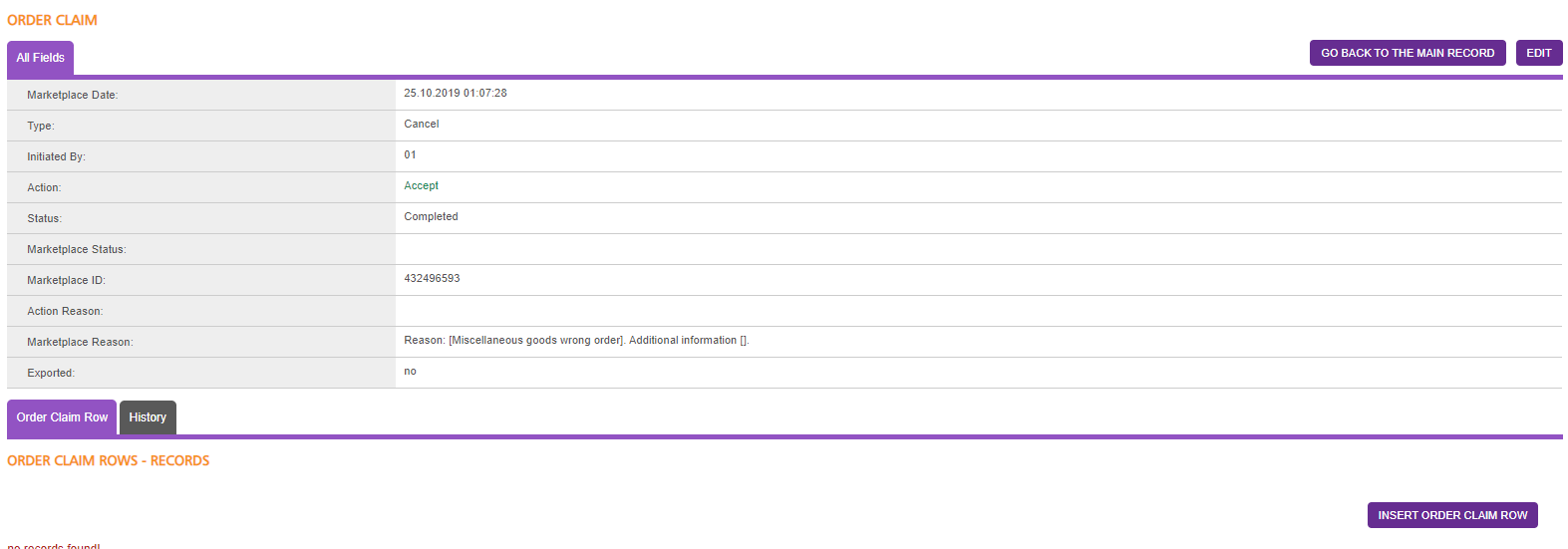11Street Korea User Guide
As 11street Korea has quite a few specifics to how it works in this page you can find a description of how things work in WAPT.
1. Account set up

In the first section of the account(Main screen) you populate the standard information. Which is the marketplace, the time zone and if the account is activated.

In the first tab you add the seller again standard to what is being done for other marketplaces.
Then you have to go to the next tab which is the Account Eleven Street

From top to bottom explanation of each field and what it is supposed to have as information filled in and how:
-
Country - this is the country that the marketplace platform operates on.
-
Token - Token provided by the marketplace for each account that we are integrating to.
-
Product type - you select in here General product in order to be creating product listings. For Korea the e-voucher is not available.
-
Minors can buy (Under 18 years old) - this field represents if the product can be purchased by minors. If set to no then the product thumbnail in the search results on the marketplace will not be shown and the product will not be accessible to buyers that are under 18 years old.
-
Shipping method - 11street requires you to say what will be your shipping method when selecting courier service this means you are going to be using your own shipping service
-
Delivery type - This is the way the delivery will be charged. If you are using a specific courier rule on the marketplace you select seller condition
-
GST (VAT) code - not in use for Korea
-
GST Flat rate percent - set to 01 so 11 street will be using flat rate VAT percent as set on the 11street account.
-
Code of Country of Origin - this shows 11 street in if the country of origin is domestic or overseas
-
Regional Code of Country of Origin - this is where you select the country of origin of the products. This is the default value for all items. If you want to display a specific country for a specific item you need to set it up on product account.
-
Default Cancellation action - default action to be performed when receiving Cancellation requests
-
Default Return action - default action to be performed when receiving Return requests
-
Default Exchange action - default action to be performed when receiving Exchange requests
-
Sell date begin - starting time of the selling period in which the item will be available
-
Sell date end - ending time of the selling period in which the item will be available
-
Delivery area code - where is the seller shipping to
-
Delivery shipping method - 11street requires you to say what will be your shipping method when selecting courier service this means you are going to be using your own shipping service for Korea specifically
-
Combined shipping - does the seller allow combined shipment of the cart
-
Shipping payment method - for 11Street Korea the methods for paying the shipping can be either when making the purchase or after that. Pre-payment required means that 11street will charge the shipping cost directly when the purchase is made.
-
Jeju delivery cost - specific delivery cost to Jeju region
-
Island delivery cost - specific delivery cost to Island region
-
Warehouse ID - it's set on the marketplace account directly if you set the value to value the marketplace will take what is set on the account
-
Return cost - specific cost for returns
-
Exchange cost (one-way) - specific cost for exchange if the seller charges only for the one way cost of the courier
-
Exchange cost (two-way) - specific cost for exchange if the seller charges for both ways cast of the courier
-
Final mile delivery - who does the final mile delivery - either 11street or the Merchant
-
Delivery provider - one of the delivery providers from a list provided by 11street
-
Dispatch template - in order to set the dispatch time you have to set templates on the 11street and then use them from when creating listings
-
Immediate shipping - if you want to mark as shipped the orders when you download them to prevent cancellation you have to enable this option
-
Return policy description - free text description of your return policy (is it going to be 30 days etc.)
Next section - Account stock profile is working in the standard way
Next section - Shipping template from here the only important thing you have to populate is if the shipping is domestic or international.
Next section - Account Location works in the standard way
Next section - Payment is not in use for this integration
Next section - Return Policy - from this section only the field Return Policy Description is in use for this integration.
Next section - Location Address - this section is not in use for this integration
Next section - Design Template - it works in the standard way
2. Product and Product Account - creating listings
In the product section there is nothing specific when creating new SKU's. We are not sending EAN, UPC, ISBN or MPN as they are not needed on 11street Korea.
In the product account there are a lot of specifics.
First when we go in the Item Specifics there are a few in there that are required.

company
brand
model_number
weight -
group1CertificationType - mandatory
group1CertificationCode - mandatory only if the group1CertificationType is imported with value 01
group1CertificationNumber - mandatory only if the group1CertificationType is imported with value 01
group2CertificationType - mandatory
group2CertificationCode - mandatory only if the group2CertificationType is imported with value 01
group2CertificationNumber - mandatory only if the group2CertificationType is imported with value 01
group3CertificationType - mandatory
group3CertificationCode - mandatory only if the group3CertificationType is imported with value 01
group3CertificationNumber - mandatory only if the group3CertificationType is imported with value 01
group4CertificationType - mandatory
group4CertificationCode - mandatory only if the group4CertificationType is imported with value 01
group4CertificationNumber - mandatory only if the group4CertificationType is imported with value 01
KC certification explanation and taxonomy.xlsx
Other specific thing for 11street Korea is the notifications. Those are some Item Specifics that are specific for 11street Korea and are categorised in a separate categorisation.
In here you can find the taxonomy for those Notifications -
11street notification values.xlsx
How to set the Notifications in WAPT:
In product account eleven street which can be found at the bottom of the product account screen as shown below:

You can find a table similar to the
Item Specifics
table. It works in the same way and it looks like this:

11street notification values.xlsx
First the category has a specific numeric ID then for each property you have a specific numeric ID that you have to input as header (Property) and a Value which is free text. This is going to be displayed in the listing on 11Street and is very important to be correctly populated.
Quantity buffer
The new options are available in Item Account Eleven Street and they are called: Quantity Limit Type- this is a drop down with only one option for the moment Limit per time. This option allows you to limit the quantity per user (per basket) for listing lifetime on 11str.
Quantity limit - This basically indicates the limit.
For example the below case will:
Limit all users on 11str to be able to purchase the listing with max 2 qty per order for the lifetime of the product. All fields are available for bulk update and import.
If you would like to import it the correct enums for Quantity limit type are: No limit - 00 Limit per Time - 01
Quantity Limit is a whole number
Example file structure:
3. Returns, Exchanges and Cancellations:
As explained above during the setup phase you can define what would be the default behaviour for each of these types of orders. You can chose Hemi to do automatically a given action as show below:

What would the above mean?
It means that every time we receive an Exchange request we would try to send Reject action for the given request. So in the same manner we can set a default behaviour for each request.
Why would we do that?
Because a seller might not be able to do Exchanges for the given market and in that case instead of receiving bad reviews and bad metrics we would like to take care of this exchange before it causes a problem.
All of these requests in Hemi are located in the Claim section as shown below:

The whole section can be found in the order under the tab claims.
It shows the type of the claim, who initiated it, what action has been selected to be performed, the status of the actual claim, if there is a marketplace status, if there is a marketplace id, in the action reason we input something if we want for internal use, in the marketplace reason we input the reason provided by the marketplace and as we have the option to export it in some custom integrations there is a flag that should be used when we do export such.



